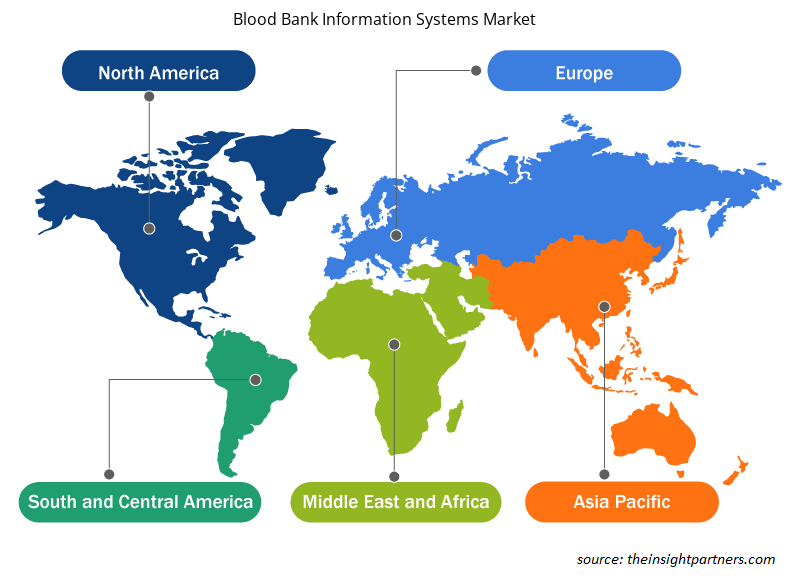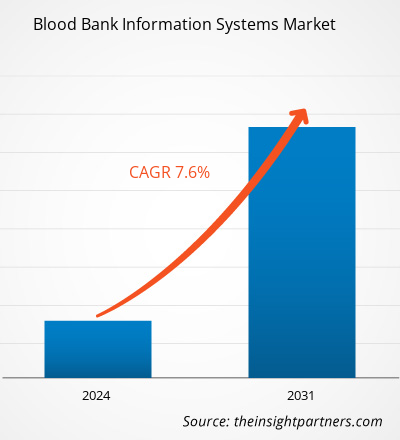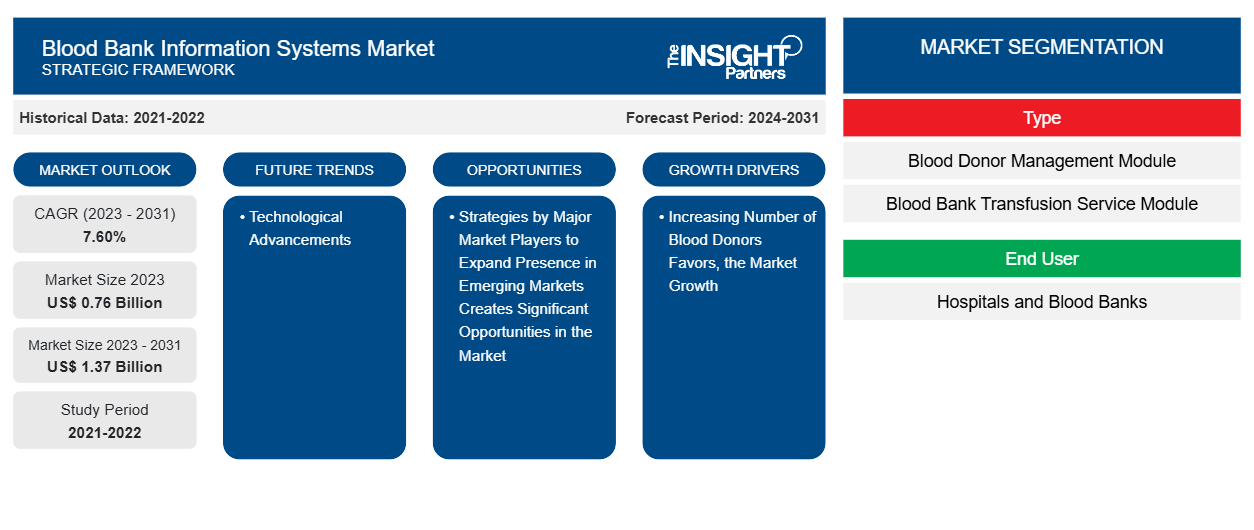Se proyecta que el tamaño del mercado de sistemas de información de bancos de sangre alcance los 1.370 millones de dólares estadounidenses en 2031, frente a los 760 millones de dólares estadounidenses en 2023. Se espera que el mercado registre una CAGR del 7,60 % durante el período 2023-2031. Es probable que el avance tecnológico siga siendo una tendencia clave en el mercado.
Análisis del mercado de sistemas de información de bancos de sangre
Las empresas se esfuerzan por introducir nuevos productos y aumentar sus operaciones a través de diversos métodos debería estimular el mercado. Empresas como Cerner Corporation, Allscripts Healthcare, LLC, Haemonetics Corporation, WellSky, Hemosoft, Integrated Medical Systems, Soft Computer Consultants, Inc., IT Synergistics, Psyche Systems Corporation y Sunquest Information Systems, Inc. han implementado una variedad de estrategias, que incluyen lanzamientos de productos, aprobaciones de productos, fusiones y adquisiciones e iniciativas de mercado. Por ejemplo, CliniSys anunció en enero de 2022 que había adquirido recientemente HORIZON Lab Systems y se había combinado con Sunquest Information Systems para convertirse en CliniSys.
Descripción general del mercado de sistemas de información de bancos de sangre
El aumento de la prevalencia mundial de enfermedades hematológicas aumenta la demanda de donaciones de sangre. Cada tres minutos, en Estados Unidos, se diagnostica a una persona leucemia, linfoma o mieloma, según la Sociedad de Leucemia y Linfoma (LLS). Además, en 2021, se notificaron unos 186.400 casos de leucemia, linfoma y mieloma en Estados Unidos. Además, en 2021, los casos de cáncer de sangre representaron aproximadamente el 9,8% de los 1.898.160 nuevos casos de cáncer estimados en el país. Los trasplantes de células de médula ósea y las transfusiones de sangre son cada vez más comunes debido a la creciente incidencia de cánceres de la sangre como la leucemia. La Cruz Roja Estadounidense estima que cada día se necesitan unas 5.000 plaquetas, 6.500 unidades de plasma y unas 29.000 unidades de sangre roja en Estados Unidos para diversos trastornos hematológicos.
Además, en Estados Unidos se transfunden anualmente 16 millones de componentes sanguíneos para tratar diversas enfermedades relacionadas con la sangre, como el cáncer de sangre y otras. Además, se ha informado que en 2020, más de 1,8 millones de personas recibieron un diagnóstico de cáncer. Como resultado, la necesidad de transfusiones de sangre está aumentando debido al aumento de las enfermedades hematológicas, lo que impulsa el crecimiento del mercado mundial de sistemas de información de bancos de sangre.
Personalice este informe según sus necesidades
Obtendrá personalización en cualquier informe, sin cargo, incluidas partes de este informe o análisis a nivel de país, paquete de datos de Excel, así como también grandes ofertas y descuentos para empresas emergentes y universidades.
- Obtenga las principales tendencias clave del mercado de este informe.Esta muestra GRATUITA incluirá análisis de datos, desde tendencias del mercado hasta estimaciones y pronósticos.
Impulsores y oportunidades del mercado de sistemas de información de bancos de sangre
El aumento del número de donantes de sangre favorece el crecimiento del mercado
Debido a la mayor frecuencia de accidentes y a la creciente prevalencia de enfermedades hematológicas, existe una creciente demanda mundial de sangre. La Organización Mundial de la Salud (OMS) estima que se donan aproximadamente 118,4 millones de unidades de sangre en todo el mundo. De las cuales, los países de altos ingresos recolectan el 40% de la sangre. Además, unos 13.300 bancos de sangre repartidos en 169 países notifican 106 millones de donaciones anuales. Además, según la OMS, el 33% de los donantes de sangre en todo el mundo son mujeres.
Además, la OMS informó que entre 2013 y 2018, 156 países informaron un aumento de 7,8 millones de donaciones de sangre voluntarias no remuneradas. Las regiones con los aumentos más significativos en las donaciones de sangre voluntarias pendientes son África (23%) y las Américas (25%). El Pacífico occidental informó el aumento más significativo en números absolutos de donaciones (2,67 millones), seguido de las Américas (2,66 millones) y el Sudeste Asiático (2,37 millones). Además, las donaciones de sangre voluntarias no remuneradas representan más del 90% del suministro de sangre en aproximadamente 79 países, que comprenden 38 países de ingresos altos, 33 países de ingresos medios y ocho países de ingresos bajos. Además, 62 naciones obtienen su suministro de sangre de donantes voluntarios no remunerados.
Además, más de la mitad del suministro de sangre del mundo (56 países, nueve de ingresos altos, 37 de ingresos medios y 10 de ingresos bajos) depende de donantes remunerados y familiares. Esto aumenta la necesidad mundial de sistemas de información de bancos de sangre. A medida que aumentan los donantes de sangre en todo el mundo, los bancos de sangre gestionan y almacenan la sangre de formas nuevas e innovadoras. Los sistemas de información de bancos de sangre se utilizan principalmente para recolectar donaciones de sangre. Por ejemplo, en 2020 Samson Oloruntoba y otros editores publicaron un informe sobre el desarrollo de un sistema de recuperación de sangre para ayudar a administrar los registros de donantes de sangre y regular la distribución de sangre en los hospitales gubernamentales. El sistema ofrece a los registros de donantes un acceso rápido a los informes médicos de manera oportuna, eficiente y confidencial. Su base es un sistema de inventario de donaciones de sangre basado en Android y la web que enfatiza la reducción de errores de transfusión. Estos elementos respaldan la expansión del mercado de los sistemas de información de bancos de sangre.Oloruntoba and other publishers. The system offers donor records quick access to medical reports in a timely, efficient, and confidential manner. Its foundation is an Android- and web-based blood donation inventory system emphasizing lowering transfusion errors. These elements support the market expansion for blood bank information systems.
Las estrategias de los principales actores del mercado para ampliar su presencia en los mercados emergentes crean oportunidades significativas en el mercado
Debido al creciente número de donantes de sangre en Asia-Pacífico y América del Sur y Central, los actores del mercado de sistemas de información de bancos de sangre planean su crecimiento en múltiples áreas. El aprendizaje profundo ha demostrado un rendimiento prometedor en la gestión de la sangre mediante el empleo de sistemas tradicionales de gestión de donantes de sangre y módulos de servicio de transfusión de bancos de sangre. Últimamente, el sistema de información de bancos de sangre ha atraído mucha atención de la investigación. En los próximos años, se prevé que numerosas empresas, incluidas WellSky, Sunset Information Systems, SCC Soft Computer's Blood Bank y Allscripts Healthcare Solutions, sigan expandiéndose en estos mercados en desarrollo a través de fusiones, adquisiciones y alianzas estratégicas. En junio de 2018, uno de los mejores hospitales pediátricos de Colorado utilizó el software Mediware de WellSky para los servicios de gestión de sangre. El software ofrece herramientas para respaldar los procedimientos que garantizan que los niños obtengan la variedad de productos sanguíneos que necesitan. Los hospitales implementaron tres soluciones de gestión de sangre de Mediware (HCLL, LifeTrak y Trastem) para gestionar la cadena de suministro de sangre. Psyche Systems Corporation, Cerner Corporation, Haemonetics Corporation, Hemosoft y otras empresas han establecido ofertas de servicios a lo largo de los años, lo que indica su posicionamiento estratégico en la región. Durante el período de proyección, estas oportunidades de mercado respaldarán la expansión del sistema de información del banco de sangre.WellSky, Sunset Information Systems, SCC Soft Computer's Blood Bank, and Allscripts Healthcare Solutions—will keep expanding in these developing markets through mergers, acquisitions, and strategic alliances. In June 2018, one of the best pediatric hospitals in Colorado used WellSky's Mediware Software for blood management services. The software offers tools to support the procedures that guarantee kids get the variety of blood products they require. The hospitals implemented three blood management solutions from Mediware—HCLL, LifeTrak, and Trastem—to handle the blood supply chain. Psyche Systems Corporation, Cerner Corporation, Haemonetics Corporation, Hemosoft, and other companies have established service offerings over the years, indicating their strategic positioning in the region. Throughout the projection period, these market opportunities will support the expansion of the blood bank information system.
Análisis de segmentación del informe de mercado de sistemas de información de bancos de sangre
Los segmentos clave que contribuyeron a la derivación del análisis del mercado de sistemas de información de bancos de sangre son el tipo y el usuario final.
- Según el tipo, el mercado de sistemas de información de bancos de sangre se segmenta en módulos de gestión de donantes de sangre, módulos de servicios de transfusión de bancos de sangre y otros. El segmento de módulos de gestión de donantes de sangre tuvo la participación de mercado más significativa en 2023.
- Por usuario final, el mercado está segmentado en hospitales y bancos de sangre. El segmento de hospitales tuvo una participación significativa del mercado en 2023.
Análisis de la cuota de mercado de los sistemas de información de bancos de sangre por geografía
El alcance geográfico del informe de mercado de sistemas de información de bancos de sangre se divide principalmente en cinco regiones: América del Norte, Asia Pacífico, Europa, Medio Oriente y África, y América del Sur y Central.
El mercado de sistemas de información de bancos de sangre de América del Norte está segmentado en Estados Unidos, Canadá y México. América del Norte domina el mercado mundial de sistemas de información de bancos de sangre, lo que se espera que continúe durante el período proyectado. Se espera que América del Norte tenga la mayor participación de mercado durante el período de proyección. Esto se debe a la creciente necesidad de transfusiones de sangre seguras y al creciente número de hospitales y bancos de sangre de la región. Esta expansión también se ha visto facilitada por una mayor conciencia pública sobre la importancia de la donación de sangre. Debido a que Estados Unidos tiene un sistema pluralista de recolección de sangre, no existe un repositorio central de datos sobre el número de unidades de sangre recolectadas o los componentes producidos o transfundidos. La Cruz Roja Americana (ARC) recolecta alrededor del 45 por ciento de los 14 millones de unidades de sangre total disponibles anualmente en Estados Unidos. Otros bancos de sangre comunitarios recolectan alrededor del 42 por ciento, los hospitales recolectan alrededor del 11 por ciento y el 2 por ciento restante se importa. Los bancos de sangre de los hospitales deben tener un sistema de información basado en computadora para cumplir con los requisitos. Este sistema simplifica la gestión del banco de sangre y garantiza la seguridad del almacenamiento, la distribución y la trazabilidad de la sangre y los componentes sanguíneos. Permite la creación de un expediente médico para cada paciente transfundido que contiene las características de los componentes sanguíneos transfundidos así como el estado inmunofarmacológico del paciente, el cual se recibe desde la institución sanguínea vía intercambio electrónico de datos.
Perspectivas regionales del mercado de sistemas de información de bancos de sangre
Los analistas de Insight Partners explicaron en detalle las tendencias y los factores regionales que influyen en el mercado de sistemas de información de bancos de sangre durante el período de pronóstico. Esta sección también analiza los segmentos y la geografía del mercado de sistemas de información de bancos de sangre en América del Norte, Europa, Asia Pacífico, Oriente Medio y África, y América del Sur y Central.

- Obtenga datos regionales específicos para el mercado de sistemas de información de bancos de sangre
Alcance del informe de mercado de sistemas de información de bancos de sangre
| Atributo del informe | Detalles |
|---|---|
| Tamaño del mercado en 2023 | 0,76 mil millones de dólares estadounidenses |
| Tamaño del mercado en 2031 | 1.370 millones de dólares estadounidenses |
| CAGR global (2023 - 2031) | 7,60% |
| Datos históricos | 2021-2022 |
| Período de pronóstico | 2024-2031 |
| Segmentos cubiertos | Por tipo
|
| Regiones y países cubiertos | América del norte
|
| Líderes del mercado y perfiles de empresas clave |
|
Densidad de actores del mercado de sistemas de información de bancos de sangre: comprensión de su impacto en la dinámica empresarial
El mercado de sistemas de información para bancos de sangre está creciendo rápidamente, impulsado por la creciente demanda de los usuarios finales debido a factores como la evolución de las preferencias de los consumidores, los avances tecnológicos y una mayor conciencia de los beneficios del producto. A medida que aumenta la demanda, las empresas amplían sus ofertas, innovan para satisfacer las necesidades de los consumidores y aprovechan las tendencias emergentes, lo que impulsa aún más el crecimiento del mercado.
La densidad de actores del mercado se refiere a la distribución de las empresas o firmas que operan dentro de un mercado o industria en particular. Indica cuántos competidores (actores del mercado) están presentes en un espacio de mercado determinado en relación con su tamaño o valor total de mercado.
Las principales empresas que operan en el mercado de sistemas de información de bancos de sangre son:
- Hemostasia
- Corporación Cerner
- Allscripts Salud, LLC
- Corporación Haemonetics
- Sistemas médicos integrados
- Consultores de informática blanda, Inc.
Descargo de responsabilidad : Las empresas enumeradas anteriormente no están clasificadas en ningún orden particular.

- Obtenga una descripción general de los principales actores clave del mercado de sistemas de información de bancos de sangre
Noticias y desarrollos recientes del mercado de sistemas de información de bancos de sangre
El mercado de sistemas de información para bancos de sangre se evalúa mediante la recopilación de datos cualitativos y cuantitativos a partir de una investigación primaria y secundaria, que incluye publicaciones corporativas importantes, datos de asociaciones y bases de datos. A continuación, se enumeran algunos de los avances en el mercado de sistemas de información para bancos de sangre:
- MAK-System, líder mundial en sistemas de gestión de sangre, se enorgullece de anunciar una asociación ampliada y estratégica con New York Blood Center Enterprises (NYBCe). Según el acuerdo, MAK-System operará la plataforma MAK.care como un servicio gestionado, gestionando todo el ecosistema digital en nombre de NYBCe. El acuerdo de 10 años transformará la forma en que se gestiona y se entrega la sangre a los pacientes aprovechando los beneficios de los servicios gestionados. (Fuente: MAK-System, comunicado de prensa, junio de 2023)
- CliniSys ha anunciado la reciente adquisición de HORIZON Lab Systems y la combinación con Sunquest Information Systems para formar CliniSys. Esta adquisición y la combinación con Sunquest crean una de las organizaciones más grandes del mundo dedicada a la informática de diagnóstico y de laboratorio. (Fuente: Sunquest Information Systems, Inc., comunicado de prensa, enero de 2022)
Informe sobre el mercado de sistemas de información de bancos de sangre: cobertura y resultados
El informe “Tamaño y pronóstico del mercado de sistemas de información de bancos de sangre (2021-2031)” proporciona un análisis detallado del mercado que cubre las siguientes áreas:
- Tamaño del mercado de sistemas de información de bancos de sangre y pronóstico a nivel mundial, regional y nacional para todos los segmentos clave del mercado cubiertos bajo el alcance
- Tendencias del mercado de sistemas de información de bancos de sangre, así como dinámica del mercado, como impulsores, restricciones y oportunidades clave
- Análisis detallado de las cinco fuerzas de Porter y PEST y FODA
- Análisis del mercado de sistemas de información de bancos de sangre que cubre las tendencias clave del mercado, el marco global y regional, los principales actores, las regulaciones y los desarrollos recientes del mercado.
- Análisis del panorama de la industria y de la competencia que abarca la concentración del mercado, el análisis de mapas de calor, los actores destacados y los desarrollos recientes del mercado de sistemas de información de bancos de sangre
- Perfiles detallados de empresas
- Análisis histórico (2 años), año base, pronóstico (7 años) con CAGR
- Análisis PEST y FODA
- Tamaño del mercado, valor/volumen: global, regional y nacional
- Industria y panorama competitivo
- Conjunto de datos de Excel
Informes recientes
Informes relacionados
Testimonios
Razón para comprar
- Toma de decisiones informada
- Comprensión de la dinámica del mercado
- Análisis competitivo
- Información sobre clientes
- Pronósticos del mercado
- Mitigación de riesgos
- Planificación estratégica
- Justificación de la inversión
- Identificación de mercados emergentes
- Mejora de las estrategias de marketing
- Impulso de la eficiencia operativa
- Alineación con las tendencias regulatorias





















 Obtenga una muestra gratuita para - Mercado de sistemas de información de bancos de sangre
Obtenga una muestra gratuita para - Mercado de sistemas de información de bancos de sangre